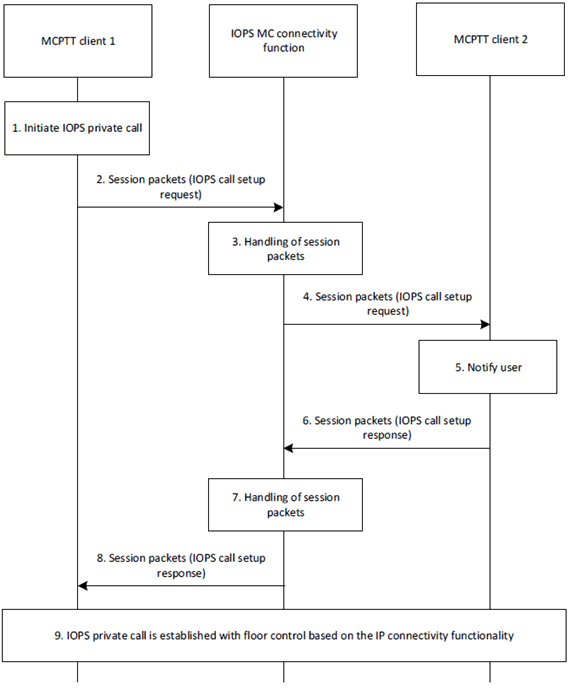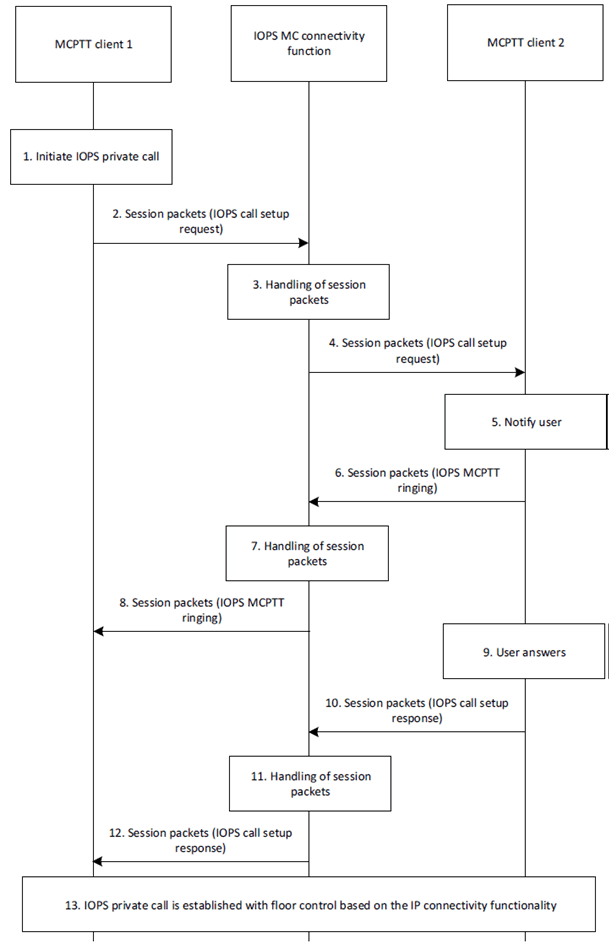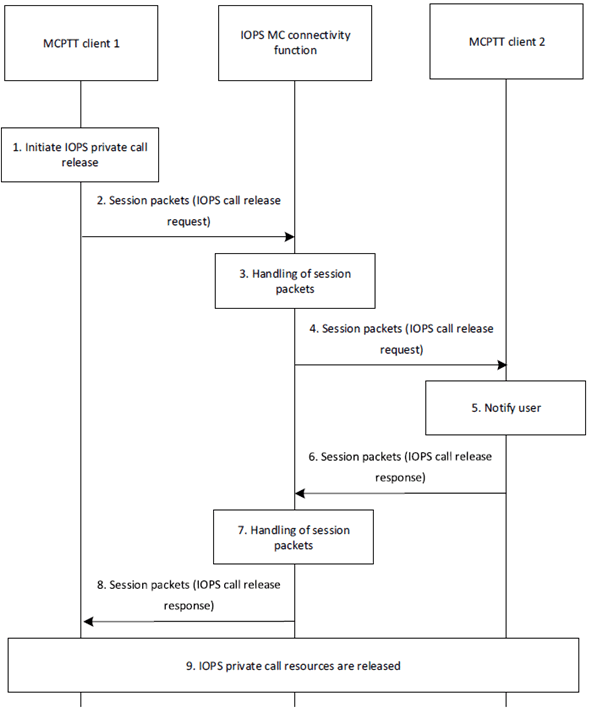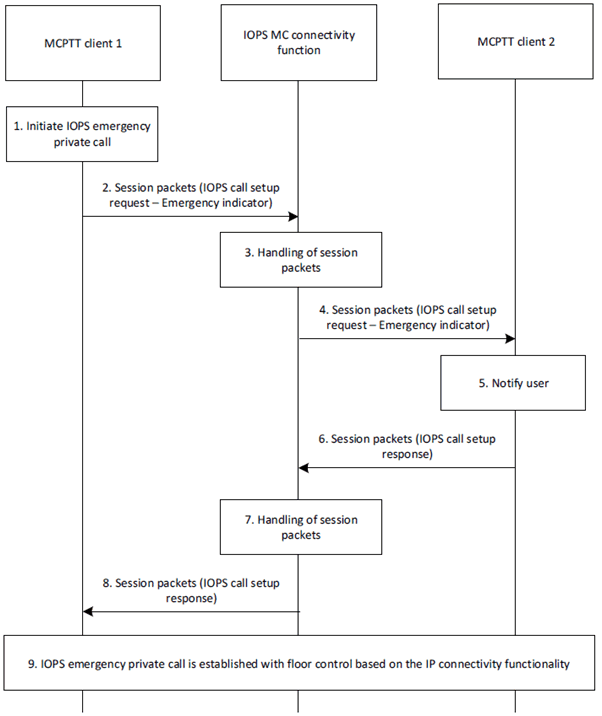Content for TS 23.180 Word version: 18.0.0
10.5.2 IOPS private call (IP connectivity functionality)
10.5.2.1 General
10.5.2.2 Information flows
10.5.2.3 IOPS private call setup in automatic commencement mode procedure
10.5.2.4 IOPS private call setup in manual commencement mode procedure
10.5.2.5 IOPS private call release
10.5.2.6 IOPS emergency private call
...
...
10.5.2 IOPS private call (IP connectivity functionality) p. 36
10.5.2.1 General p. 36
The support of MCPTT private calls based on the IP connectivity functionality in the IOPS mode of operation enables that the service is provided by the MCPTT clients over the IOPS MC connectivity function. The IOPS MC connectivity function provides IP connectivity for the communication among MCPTT users.
When an MCPTT user wants to communicate with a specific target MCPTT user based on the IP connectivity functionality, the MCPTT client retrieves the connectivity information of the target MCPTT user (i.e. the MCPTT UE's IP address) from the IOPS connectivity client. Then, the MCPTT clients enable establishing the IOPS private call over the IOPS MC connectivity function. The related session packets, i.e. signalling and media, of the IOPS private call are transmitted to the IOPS MC connectivity function addressing the corresponding target MCPTT UE's IP address.
The IOPS MC connectivity function distributes the received session packets over unicast transmissions to the target MCPTT client.
IOPS private calls can be setup in two different commencement modes, automatic commencement mode and manual commencement mode.
The following clauses specify the IOPS private call procedures and information flows for the IP connectivity functionality in the IOPS mode of operation.
10.5.2.2 Information flows p. 37
10.5.2.2.1 IOPS call setup request p. 37
Table 10.5.2.2.1-1 describes the information flow for the IOPS call setup request from one MCPTT client to another MCPTT client. The packet(s) carrying the IOPS call setup request are transmitted from the calling MCPTT client to the IOPS MC connectivity function for distribution to the called MCPTT client.
| Information Element | Status | Description |
|---|---|---|
| IOPS MCPTT ID | M | The identity of the calling party |
| IOPS MCPTT ID | M | The identity of the called party |
| SDP offer for the IOPS private call | M | SDP with media information offered by (to) client |
| Location information | O | Location of the calling party |
| Requested commencement mode | O | An indication that is included if the user is requesting a particular commencement mode |
| Implicit floor request | O | An indication that the user is also requesting the floor. |
| Emergency indicator | O | Indicates that the MCPTT private call is an MCPTT emergency call |
10.5.2.2.2 IOPS call setup response p. 37
Table 10.5.2.2.2-1 describes the information flow for the IOPS call setup response from one MCPTT client to another MCPTT client. The packet(s) carrying the IOPS call setup response are transmitted from the called MCPTT client to the IOPS MC connectivity function for distribution to the calling MCPTT client.
| Information Element | Status | Description |
|---|---|---|
| IOPS MCPTT ID | M | The identity of the calling party |
| IOPS MCPTT ID | M | The identity of the called party |
| SDP answer for private call | M | SDP with media parameters selected |
| Acceptance confirmation | O | An indication whether the user has positively accepted the call. |
10.5.2.2.3 IOPS MCPTT ringing p. 37
Table 10.5.2.2.3-1 describes the information flow for the IOPS MCPTT ringing from one MCPTT client to another MCPTT client. The packet(s) carrying the IOPS MCPTT ringing are transmitted from the called MCPTT client to the IOPS MC connectivity function for distribution to the calling MCPTT client.
| Information Element | Status | Description |
|---|---|---|
| IOPS MCPTT ID | M | The MCPTT ID of the calling party |
| IOPS MCPTT ID | M | The MCPTT ID of the called party |
| Ringing indication | O | Indication to the caller |
10.5.2.2.4 IOPS call release request p. 38
Table 10.5.2.2.4-1 describes the information flow for the IOPS call release request from one MCPTT client to another MCPTT client. The packet(s) carrying the IOPS call release request are transmitted from one MCPTT client to the IOPS MC connectivity function for distribution to the other MCPTT client.
| Information Element | Status | Description |
|---|---|---|
| IOPS MCPTT ID | M | The identity of the calling party |
| IOPS MCPTT ID | M | The identity of the called party |
| MCPTT private call release reason | O | This element indicates the reason for the private call release. e.g., Originating client requested |
10.5.2.2.5 IOPS call release response p. 38
Table 10.5.2.2.5-1 describes the information flow for the IOPS call release response from one MCPTT client to another MCPTT client. The packet(s) carrying the IOPS call release response are transmitted from one MCPTT client to the IOPS MC connectivity function for distribution to the other MCPTT client.
| Information Element | Status | Description |
|---|---|---|
| IOPS MCPTT ID | M | The identity of the calling party |
| IOPS MCPTT ID | M | The identity of the called party |
10.5.2.2.6 IOPS emergency private call upgrade p. 38
Table 10.5.2.2.6-1 describes the information flow for the IOPS emergency private call upgrade from one MCPTT client to another MCPTT client. The packet(s) carrying the IOPS emergency private call upgrade are transmitted from the originating MCPTT client to the IOPS MC connectivity function for distribution to the target MCPTT client.
| Information Element | Status | Description |
|---|---|---|
| IOPS MCPTT ID | M | The identity of the calling party |
| IOPS MCPTT ID | M | The identity of the called party |
10.5.2.3 IOPS private call setup in automatic commencement mode procedure p. 38
The procedure in Figure 10.5.2.3-1 is the basic procedure for an MCPTT client initiating the establishment of an IOPS MCPTT private call with a target MCPTT client based on the IP connectivity functionality.
The procedure focuses on the case of an IOPS MCPTT private call using an automatic commencement mode.
Pre-conditions:
- MCPTT user profile used for the IOPS mode of operation is pre-provisioned in the MCPTT UEs.
- MCPTT users have an active PDN connection to the IOPS MC connectivity function for the communication based on the IP connectivity functionality
- The MCPTT users are discovered by the IOPS MC connectivity function supporting the IP connectivity functionality.
- MCPTT clients have retrieved connectivity information from target MCPTT users.

Figure 10.5.2.3-1: IOPS private call setup in automatic commencement mode based on the IP connectivity functionality
(⇒ copy of original 3GPP image)
(⇒ copy of original 3GPP image)
Step 1.
The MCPTT user at MCPTT client 1 would like to initiate an IOPS private call with the MCPTT user at MCPTT client 2 based on the IP connectivity functionality.
Step 2.
The MCPTT client 1 retrieves the connectivity information of the target MCPTT user from the IOPS connectivity client 1 (not shown in Figure) and sends an IOPS call setup request towards the MCPTT client 2. The MCPTT client 1 transmits the session packets carrying the IOPS call setup request to the IOPS MC connectivity function for distribution to the corresponding target MCPTT UE 2's IP address.
The IOPS call setup request contains an SDP offer, an automatic commencement mode indication, and an element that indicates that MCPTT client 1 is requesting the floor. The IOPS private call request may include location information.
Step 3.
The IOPS MC connectivity function receives the session packets addressing the MCPTT UE 2's IP address. The IOPS MC connectivity function checks if the MCPTT UE 2's IP address corresponds to a discovered MC user in order to distribute the received session packets. If it does, the IOPS MC connectivity function distributes the received session packets to the target MCPTT client over unicast transmissions.
Step 4.
The IOPS MC connectivity function distributes the session packets carrying the IOPS call setup request to the MCPTT client 2.
Step 5.
The MCPTT client 2 notifies the target MCPTT user about the incoming IOPS private call.
Step 6.
The receiving MCPTT client 2 accepts the IOPS private call automatically, and an IOPS call setup response indicating the successful call establishment is sent to MCPTT client 1. The MCPTT client 2 transmits the session packet(s) carrying the IOPS call setup response to the IOPS MC connectivity function for distribution to the corresponding target MCPTT UE 1's IP address.
If MCPTT client 2 rejected the incoming call, the MCPTT client 2 sends an IOPS call setup response indicating the failure reason to the MCPTT client 1.
Step 7.
The IOPS MC connectivity function receives the session packets addressing the MCPTT UE 1's IP address. The IOPS MC connectivity function checks if the MCPTT UE 1's IP address corresponds to a discovered MC user in order to distribute the received session packets. If it does, the IOPS MC connectivity function distributes the received session packets to the target MCPTT client over unicast transmissions.
Step 8.
The IOPS MC connectivity function distributes the session packets carrying the IOPS call setup response to the MCPTT client 1.
Step 9.
The MCPTT client 1 and the MCPTT client 2 have successfully established the IOPS private call with floor control based on the IP connectivity functionality. The MCPTT client 1 is automatically granted the floor.
10.5.2.4 IOPS private call setup in manual commencement mode procedure p. 40
The procedure in Figure 10.5.2.4-1 focuses on the case where an MCPTT user is initiating an IOPS MCPTT private call for communicating with another MCPTT user using a manual commencement mode. The IOPS MCPTT private call is based on the IP connectivity functionality.
Pre-conditions:
- MCPTT user profile used for the IOPS mode of operation is pre-provisioned in the MCPTT UEs.
- MCPTT users have an active PDN connection to the IOPS MC connectivity function for the communication based on the IP connectivity functionality.
- The MCPTT users are discovered by the IOPS MC connectivity function supporting the IP connectivity functionality.
- MCPTT clients have retrieved connectivity information from target MCPTT users.

Figure 10.5.2.4-1: IOPS private call setup in manual commencement mode based on the IP connectivity functionality
(⇒ copy of original 3GPP image)
(⇒ copy of original 3GPP image)
Step 1.
The MCPTT user at MCPTT client 1 would like to initiate an IOPS MCPTT private call with the MCPTT user at MCPTT client 2 based on the IP connectivity functionality.
Step 2.
The MCPTT client 1 retrieves the connectivity information of the target MCPTT user from the IOPS connectivity client 1 (not shown in Figure) and sends an IOPS call setup request towards the MCPTT client 2. The MCPTT client 1 transmits the session packets carrying the IOPS call setup request to the IOPS MC connectivity function for distribution to the corresponding target MCPTT UE 2's IP address.
The IOPS call setup request contains an SDP offer, a manual commencement mode indication, and an element that indicates that MCPTT client 1 is requesting the floor. The IOPS private call request may include location information.
Step 3.
The IOPS MC connectivity function receives the session packets addressing the MCPTT UE 2's IP address. The IOPS MC connectivity function checks if the MCPTT UE 2's IP address corresponds to a discovered MC user in order to distribute the received session packets. If it does, the IOPS MC connectivity function distributes the received session packets to the MCPTT client 2 over unicast transmissions.
Step 4.
The IOPS MC connectivity function distributes the session packets carrying the IOPS call setup request to the MCPTT client 2.
Step 5.
The MCPTT client 2 notifies the target MCPTT user about the incoming IOPS private call.
Step 6.
The MCPTT client 2 sends an IOPS MCPTT ringing message to the MCPTT client 1. The MCPTT client 2 transmits the session packet(s) carrying the IOPS MCPTT ringing to the IOPS MC connectivity function for distribution to the corresponding target MCPTT UE 1's IP address.
Step 7.
The IOPS MC connectivity function receives the session packets addressing the MCPTT UE 1's IP address. The IOPS MC connectivity function checks if the MCPTT UE 1's IP address corresponds to a discovered MC user in order to distribute the received session packets. If it does, the IOPS MC connectivity function distributes the received session packets to the MCPTT client 1 over unicast transmissions.
Step 8.
The IOPS MC connectivity function distributes the session packets carrying the IOPS MCPTT ringing to the MCPTT client 1.
Step 9.
The MCPTT user at the MCPTT client 2 has accepted the call using manual commencement mode (i.e., it has taken some action to accept it via the user interface). The MCPTT user may also reject or fail to answer the incoming call.
Step 10.
The MCPTT client 2 sends an IOPS call setup response indicating the successful call establishment to the MCPTT client 1. If the MCPTT client 2 rejected the call or the MCPTT user 2 rejected or failed to answer the incoming call, the MCPTT client 2 sends an IOPS call setup response indicating the failure reason to the MCPTT client 1. The MCPTT client 2 transmits the session packet(s) carrying the IOPS call setup response to the IOPS MC connectivity function for distribution to the corresponding target MCPTT UE 1's IP address.
Step 11.
The IOPS MC connectivity function receives the session packets addressing the MCPTT UE 1's IP address. The IOPS MC connectivity function checks if the MCPTT UE 1's IP address corresponds to a discovered MC user in order to distribute the received session packets. If it does, the IOPS MC connectivity function distributes the received session packets to the MCPTT client 1 over unicast transmissions.
Step 12.
The IOPS MC connectivity function distributes the session packets carrying the IOPS call setup response to the MCPTT client 1.
Step 13.
The MCPTT client 1 and the MCPTT client 2 have successfully established the IOPS private call with floor control based on the IP connectivity functionality. The MCPTT client 1 is automatically granted the floor.
10.5.2.5 IOPS private call release p. 42
The procedure in Figure 10.5.2.5-1 focuses on the case where an MCPTT client is requesting to release an ongoing IOPS MCPTT private call based on the IP connectivity functionality. Either MCPTT client can initiate the call release procedure.
Pre-conditions:
- Two MCPTT users are currently engaged in an IOPS MCPTT private call based on the IP connectivity functionality.

Figure 10.5.2.5-1: IOPS private call release based on the IP connectivity functionality
(⇒ copy of original 3GPP image)
(⇒ copy of original 3GPP image)
Step 1.
The MCPTT user at MCPTT client 1 would like to initiate an IOPS MCPTT private call release to the MCPTT user at MCPTT client 2 based on the IP connectivity functionality.
Step 2.
The MCPTT client 1 retrieves the connectivity information of the target MCPTT user from the IOPS connectivity client 1 (not shown in Figure) and sends an IOPS call release request towards the MCPTT client 2. The MCPTT client 1 transmits the session packets carrying the IOPS call release request to the IOPS MC connectivity function for distribution to the corresponding target MCPTT UE 2's IP address.
Step 3.
The IOPS MC connectivity function receives the session packets addressing the MCPTT UE 2's IP address. The IOPS MC connectivity function checks if the MCPTT UE 2's IP address corresponds to a discovered MC user in order to distribute the received session packets. If it does, the IOPS MC connectivity function distributes the received session packets to the MCPTT client 2 over unicast transmissions.
Step 4.
The IOPS MC connectivity function distributes the session packets carrying the IOPS call release request to the MCPTT client 2.
Step 5.
The MCPTT client 2 notifies the MCPTT user about the IOPS private call release.
Step 6.
The MCPTT client 2 sends an IOPS call release response indicating the successful call release to the MCPTT client 1. The MCPTT client 2 transmits the session packet(s) carrying the IOPS call release response to the IOPS MC connectivity function for distribution to the corresponding target MCPTT UE 1's IP address.
Step 7.
The IOPS MC connectivity function receives the session packets addressing the MCPTT UE 1's IP address. The IOPS MC connectivity function checks if the MCPTT UE 1's IP address corresponds to a discovered MC user in order to distribute the received session packets. If it does, the IOPS MC connectivity function distributes the received session packets to the MCPTT client 1 over unicast transmissions.
Step 8.
The IOPS MC connectivity function distributes the session packets carrying the IOPS call release response to the MCPTT client 1.
Step 9.
The MCPTT client 1 and the MCPTT client 2 release all associated call resources from the private call communication based on the IP connectivity functionality.
10.5.2.6 IOPS emergency private call p. 44
The procedure in Figure 10.5.2.6-1 is the basic procedure for an MCPTT client initiating the establishment of an IOPS emergency private call with a target MCPTT client based on the IP connectivity functionality. The IOPS emergency private call is a special case of the IOPS private call setup procedures described in clause 10.5.2.3, wherein the IOPS call setup request contains an indication that the IOPS private call is an IOPS emergency private call. The called MCPTT user can become aware of the emergency state of the calling MCPTT user based on the emergency indicator.
When an MCPTT client intends to initiate an IOPS emergency private call, the MCPTT client can request higher priority from the IOPS MC connectivity function via the IOPS discovery request.
For the case of an IOPS private call in-progress, either call participant can upgrade the call to an IOPS emergency private call by sending an IOPS emergency private call upgrade.
The emergency state of the call remains until the emergency call ends.
Pre-conditions:
- MCPTT user profile used for the IOPS mode of operation is pre-provisioned in the MCPTT UEs.
- MCPTT users have an active PDN connection to the IOPS MC connectivity function for the communication based on the IP connectivity functionality
- The MCPTT users are discovered by the IOPS MC connectivity function supporting the IP connectivity functionality.
- MCPTT clients have retrieved connectivity information from target MCPTT users.

Figure 10.5.2.6-1: IOPS emergency private call setup based on the IP connectivity functionality
(⇒ copy of original 3GPP image)
(⇒ copy of original 3GPP image)
Step 1.
The MCPTT user at MCPTT client 1 would like to initiate an IOPS emergency private call with the MCPTT user at MCPTT client 2 based on the IP connectivity functionality.
Step 2.
The MCPTT client 1 retrieves the connectivity information of the target MCPTT user from the IOPS connectivity client 1 (not shown in Figure) and sends an IOPS call setup request towards the MCPTT client 2. The request contains an indication that the call is an IOPS emergency private call. The MCPTT client 1 transmits the session packets carrying the IOPS call setup request to the IOPS MC connectivity function for distribution to the corresponding target MCPTT UE 2's IP address.
Step 3.
The IOPS MC connectivity function receives the session packets addressing the MCPTT UE 2's IP address. The IOPS MC connectivity function checks if the MCPTT UE 2's IP address corresponds to a discovered MC user in order to distribute the received session packets. If it does, the IOPS MC connectivity function distributes the received session packets to the target MCPTT client over unicast transmissions. If the MCPTT client 1 requested a priority state from the IOPS MC connectivity function, the IOPS MC connectivity function distributes the session packets with higher priority.
Step 4.
The IOPS MC connectivity function distributes the session packets carrying the IOPS call setup request to the MCPTT client 2.
Step 5.
The MCPTT client 2 notifies the target MCPTT user about the incoming IOPS emergency private call.
Step 6.
The receiving MCPTT client 2 accepts the IOPS emergency private call and an IOPS call setup response indicating the successful call establishment is sent to MCPTT client 1. The MCPTT client 2 transmits the session packet(s) carrying the IOPS call setup response to the IOPS MC connectivity function for distribution to the corresponding target MCPTT UE 1's IP address.
Step 7.
The IOPS MC connectivity function receives the session packets addressing the MCPTT UE 1's IP address. The IOPS MC connectivity function checks if the MCPTT UE 1's IP address corresponds to a discovered MC user in order to distribute the received session packets. If it does, the IOPS MC connectivity function distributes the received session packets to the target MCPTT client over unicast transmissions. If any participating MCPTT client of the call requested a priority state from the IOPS MC connectivity function, the IOPS MC connectivity function distributes the session packets with higher priority.
Step 8.
The IOPS MC connectivity function distributes the session packets carrying the IOPS call setup response to the MCPTT client 1.
Step 9.
The MCPTT client 1 and the MCPTT client 2 have successfully established the IOPS emergency private call based on the IP connectivity functionality.